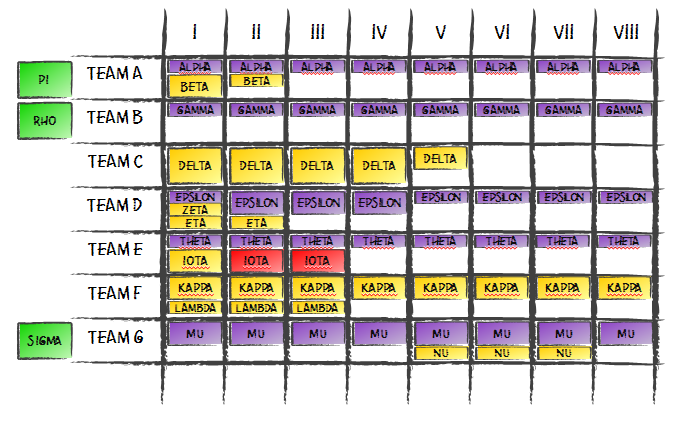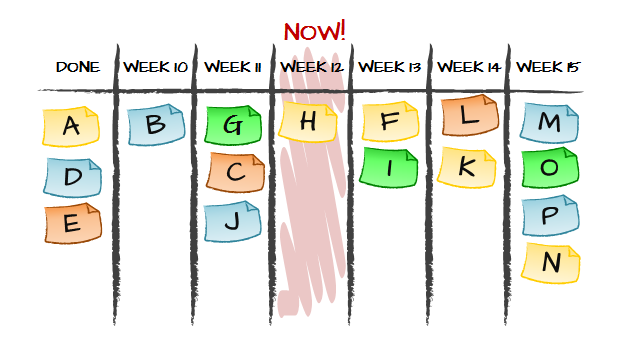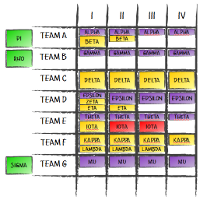One thing that I learned quickly when I started experimenting with Portfolio Kanban is that a classic, flow-driven board design isn’t particularly good in vast majority of cases.
Board Designs
Long story short, I ended up redesigning the board structure completely and it worked much better. In fact, it worked so well that I started proposing such a design as a starting point whenever working with portfolio Kanban.

Interestingly enough, as Kanban adoption of portfolio level progressed I started seeing completely different approaches to visualization. Not that they were worse. They just focused on different aspects of work.
One that popped up early was two-tier board that addresses different granularity of tasks at the same board. We can track the roots of this design to David Anderson’s time at Corbis. Since then it was picked up to manage portfolios.

Another example came from Zsolt Fabok, who was inspired by Chris Matts. What he proposed was a board that stresses expected delivery dates and how an organization is doing against these dates. Again the board design is completely different from the ones we’ve seen so far.

Another interesting example that I like is a portfolio board that visualized non-homogenous flow of work. This still is one of the most unusual board designs I’ve seen and yet it makes a perfect sense given the context.

By that time it was perfectly clear that there is no such thing as a standard design of Portfolio Kanban board. Each of these designs was fairly optimal if we considered the context. At the same time each of the boards was designed to stress a different aspect of work.
The design I ended up with in my Portfolio Kanban story revolved around available capabilities and commitments. The two-tiered board design focused on flow of coarse-grained items and breaking work down to fine grained items. The deadline driven board based on an assumption that the most critical aspect of work are delivery dates and monitoring delays. Finally, non-homogenous flow board design addressed the issue of different flows of work in each of the projects.
Which design is most useful then? It depends. To address that question we first need to answer which aspect of our work is the most important to track on a regular basis. To get that answer we need to discuss risks.
Risk Management
Obviously, risk management is a multi-dimensional issue. Some dimensions would be more interesting than others. The word “interesting” typically translates to the fact that we are more vulnerable to a specific class of risks or that we are doing especially badly against managing that class of risks.
A typical example in the context of portfolio management would be overburdening. We commit to more projects or products than we can chew. We end up having our teams juggling all the concurrent endeavors. As a result we see a lot multitasking, context switching, and huge inefficiencies.
In such a case the most interesting dimension of risks would be one related to managing available capabilities and ongoing commitments. And that would exactly be information that we’d like to focus on most when designing Portfolio Kanban board.
That’s by the way almost exactly the process I went through when I proposed capability-focused board design. Of course, back then the thought process wasn’t that structured and it was more trial and error.
There are some additional aspects of the story, like the huge variability of size of the projects that we typically see. This would affect the details of the board design as well. In this case relative size is visualized as well.
The most important bit is that we start with the most important risk dimension. This should define the whole structure of Portfolio Kanban board.
Coming back to different visualizations I mentioned we can easily figure out what was the key class of risks in each design.
In two-tiered board the biggest concern was smooth flow of coarse-grained items (feature sets). We can also figure out that variability in size of feature sets wasn’t that much of a problem. Given that we’re talking about product development organization and that they are in full control of how they define feature sets, it does make a lot of sense.
Delivery date driven board stressed how important risks related deadlines and timeliness of delivery were. We may also notice that there isn’t much stress on flow of work and not that much focus on addressing potential overburdening either.
The design with non-homogenous flow, as its name suggests, pinpoints that most important risk dimension was managing flow. On the other hand risks related to capability management and overburdening don’t seem so important.
Optimal Design
The structure of Portfolio Kanban board can show only that much. We can’t visualize all the risk dimensions using the board structure alone. David Anderson in his Enterprise Service Planning talk points that it is common that organizations track 4-8 different dimensions of risks. The board design can address one or two.
Make it the two that matter most.
Where would others go? Fortunately we still have items on our board, whatever we decide them to be. We can track information relevant for other risk dimensions using information on index cards. The design of the items on the board is no less important than the design of the board itself.
Designing Portfolio Kanban board is not an obvious task. We don’t even have a standard approach – something similar to a flow-based design we commonly use on a team level. Understanding how we manage risks is the best guidance that can lead to fairly optimal board design quickly.
Of course one alternative is to go through a trial and error process. Eventually you’d land with similar outcomes. A quicker way though is to start with understanding risks.

 Subscribe RSS feed
Subscribe RSS feed